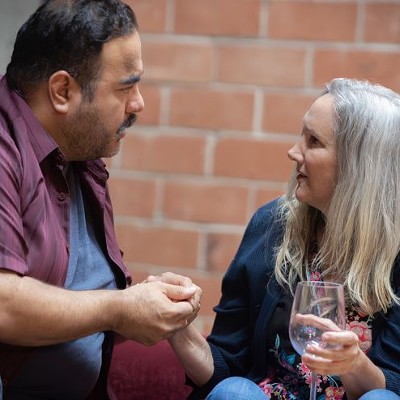Support Us
Houston's independent source of
local news and culture
account
- Welcome,
Insider - Login
- My Account
- My Newsletters
- Contribute
- Contact Us
- Sign out

Even a little harvest is exciting.
Photo by Lorretta Ruggiero
[
{
"name": "Related Stories / Support Us Combo",
"component": "11591218",
"insertPoint": "4",
"requiredCountToDisplay": "4"
},{
"name": "Air - Billboard - Inline Content",
"component": "11591214",
"insertPoint": "2/3",
"requiredCountToDisplay": "7"
},{
"name": "R1 - Beta - Mobile Only",
"component": "12287027",
"insertPoint": "8",
"requiredCountToDisplay": "8"
},{
"name": "Air - MediumRectangle - Inline Content - Mobile Display Size 2",
"component": "11591215",
"insertPoint": "12",
"requiredCountToDisplay": "12"
},{
"name": "Air - MediumRectangle - Inline Content - Mobile Display Size 2",
"component": "11591215",
"insertPoint": "4th",
"startingPoint": "16",
"requiredCountToDisplay": "12"
}
]
With all the troubles going on in the world, many of us may be tempted to veg out in front of the television binging on the must-watch shows our friends have been raving about. And sometimes we need a brief escape from the news and doom and gloom.
There are also other ways to deal with the daily bombardment of strife and sorrow. Share a meal with friends and family. Take a hike in the woods. Cuddle with your cat. Play ball with your dog. Watch Peppa Pig with your kid. It also does a body and a mind good to get in the garden and plant some vegetables and flowers that will provide physical, as well as spiritual, nourishment.
This has been a spectacularly great week in Houston weather-wise and this gardener has been taking full advantage of the sun and mild temps, only thwarted by some fiercely gusty winds. It seems not only kids and college students are on spring break because the garden centers and big box stores are crowded with shoppers eager to jump start their spring gardening and home improvements.
We don't want to dwell on the Ukrainian crisis but it does bring to mind the early days of World War II. One of the most successful campaigns in wartime Britain was the Dig for Victory movement. Inspired by the Victory Gardens of World War I, the British Ministry of Agriculture encouraged British citizens to plant their own vegetable gardens to supplement wartime rations. The United States, Australia and Canada also implemented Victory Garden campaigns as a way to deal with food shortages and a sometimes bland diet. It also kept their minds off the War, if only briefly.
In recent times, the locavore movement and the pandemic have both been instrumental in getting more Americans interested in growing their own food. Here in Houston, we have two long growing seasons, spring and fall. For spring gardens, we have to time our harvests before the intense heat of summer. That's why March is the time to, as Kool and the Gang sang, " Get down on it."
For those who haven't planted tomatoes, time is running out. Because of the late light freeze, many nursery centers delayed their shipments of vegetable transplants. And, as this gardener found out this week, the pickings are slim even now. It could be supply chain issues but I couldn't find one decent cucumber plant.
I did, however, manage to get four tomato plants in the ground just prior to last week's temps in the thirties. Tomato plants do not like temperatures below 40 degrees, so I had to cover them and they managed quite nicely. This week, I have been sowing other vegetable seeds since we aren't likely to get another freeze. That doesn't mean it won't happen but a gardener has to take chances.
For those who haven't prepared beds for vegetables, there are a number of vegetables, fruits and herbs that do well in containers. We can't promise that growing some of your own food will make a difference in your grocery bill or offer food security but we can bet that eating a fresh cherry tomato right off of a plant that you have grown yourself will give you a little thrill.
Here are some vegetables that can be planted or sown by seed now:
Beans
This could be the easiest and most productive vegetable, or legume, for novices and experts alike. The seeds are cheap and actually the best way to grow beans. There are bush types and pole types. Bush types usually don't need staking but pole beans will definitely need a trellis. I stick to bush beans and get more than my family can eat. Bush ones that do well here are Contender, Calima, Cantare and the beautifully purple-striped Dragon Tongue. Roma is a popular wax-type and Kentucky Wonder pole beans do well in our climate.
While some experts say to plant beans in late March, I have already taken a chance and sowed my first round. In a couple of weeks, I will do another sowing and then again in the fall. Succession sowing gives an extended harvest with crops such as beans. They also don't need much in the way of fertilizer because they are nitrogen-fixing plants which means they take atmospheric nitrogen and convert it into ammonium nitrogen which is then released into the soil, according to treehugger.com.
Peas
Sugar snap peas and snow peas are cool weather crops that should have been sown in January or February and really do best in Houston's fall climate. However, for those who have some extra seed that needs to be used, it can go in this month and maybe, just maybe, you will get some precious pods before the heat takes over, especially if it's in a spot that gets afternoon shade.
Some good ones for Houston are Wando, which needs trellising or Lincoln and Little Marvel, which are shorter varieties. It's another legume that is super delicious raw and we don't know why people don't eat more raw peas.
Peppers
It's too late to start peppers from seed but there are numerous varieties available by transplant and gardeners rarely need more than one plant to fill their pepper needs.
I had so many jalapenos from my El Hefe last year that I am researching how to dry them or pickle them for this season so I don't waste them. There are so many choices for cayenne, habanero, jalapeno and sweet peppers that Houston gardeners can find anything to suit their taste and heat level. And they don't grow very large so peppers can easily be grown in containers. Some of the more colorful varieties make ornamental and culinary patio specimens. I am trying Snackabelle mini bell peppers in a patio container this year.
El Hefe is the boss jalapeno for me. The Tam jalapeno developed by Texas A&M is good for those who like the taste but not the heat. I am also growing Ancho San Luis to use fresh for chile rellenos and dried for ancho chile powder. I have never made chile powder before but the internet is a good resource for learning.
Tomatoes
Get those tomato plants in now! Early Girl will give some medium size fruit before summer heat. Heirloom types may produce if the temperatures don't get too high before June. Roma, or paste types, are often determinate which means that they will produce all at once giving the gardener tomatoes for sauce-making. Most cherry types are indeterminate and will produce well into the summer and sometimes even the fall.
Tomatoes come in so many hues and flavors and a variety of cherry and saladette types will make beautiful salads. Yellow Pear, Black Cherry, Sun Gold and Sweet Chelsea are prolific and delicious.
Greens and Lettuces
It's past the time to sow seeds for most greens like mustard, collard, kale and lettuces. However, if you have a sunny spot that gets afternoon shade, give it a go. You'll at least get some baby greens that can be harvested early before the summer. Same with beets. The greens are pretty and tasty.
Cucumbers
This is another easy to grow plant and gardeners have another month to get transplants in or a couple more weeks for seeds. I couldn't find any good ones this week so I sowed a few leftover Suyo Long seeds. Japanese types usually have few seeds but they have prickly hairs that need to be brushed off with a towel before consuming.
Market More is popular in Houston and I have had success with an Israeli variety, Beit Alpha.
Melons
Growing melons in Houston can be challenging. At least it is for this Houstonian. I have had friends, though, do quite well with watermelons. I stick to musk melons, or canteloupes. I like the French varieties like Charentais because they are smaller and very fragrant. I am growing Petit Gris de Rennes this year in a cage to save space. I have never done it before, so wish me luck.
Don't expect huge harvests from backyard gardens. Just revel in the two or three ripe little melons that you might get. Hopefully before the bugs find them.
Summer Squash
Some folks do well with zucchini. I am not one of those folks. Still, I am attempting to get more than beautiful blooms (which can be eaten and are a delicacy) this year by caging them. I don't have much room left in my garden, so I am hoping this helps keep the squash plants from taking over while producing enough little globes of Ronde de Nice zucchini for stuffing. I am also doing a petit Lemon squash and Costata Romanesco from seed. Zucchini and squash, including pumpkin varieties, can be planted now or sown from seed.
Eggplant
I love eggplant and there are so many different and colorful varieties from around the world. I don't bother sowing them because they seem to take forever to grow. Transplants are much easier and good ones for Houston include Rosa Bianca, a pretty pink variety, Ichibon, a Japanese type, and Florida Market for eggplant parmesan.
Onions
The nurseries and garden centers never seem to have onion sets at the right time for planting in Houston. And it can be a bit complicated when trying to do figure out the short day, intermediate and long day varieties and requirements for our area. March is the absolute last month for planting onion sets for summer harvest.
I picked up a bunch of red onion transplants this week and I have no idea what kind they are. No matter. If they bulb, that would be great, but even if they don't, I have months of green spring onions for garnishing and adding to salads. I planted some in the garden, some in a pot and I am even going to add some to the flower beds simply because there were so many of them.
Herbs
There really is no excuse for Houstonians not to grow herbs, especially for those who love to cook. Why pay a dollar for a few sprigs of rosemary or basil when you can grow pots of them for just a couple of dollars more? Not only does growing your own herbs save money but it also saves the waste of plastic packaging that is rarely recyclable.
Herbs are easily grown in pots, a flower bed or their own dedicated garden. Basil, cilantro and parsley are easily grown from seed. If let go to seed in the summer, all three of these herbs will provide volunteers for years to come. Lavender and rosemary are best bought as plants and they will grow to be fragrant and attractive bushes. Sage, thyme and oregano are also musts for cooks and there are so many different Asian herbs that can add some interest to everyday meals.
Of course, all these plants require sun, healthy soil and water to thrive. Organic practices are best and help to create a welcoming environment for plants, pollinators, beneficial insects and wildlife, not to mention human beings. And it isn't always the easiest approach.
I didn't want to use a chemical ant killer in my vegetable garden but ants were building mounds in my raised bed. I tried pouring boiling water on the mounds prior to planting the vegetables. That worked temporarily.
This season, I am going to try a tip I saw at the University of Houston's School of Sustainability website. It recommends pouring coffee grounds around the soil to deter ants. It also recommends crushed eggshells spread atop the soil to repel slugs. Both coffee grounds and eggshells will breakdown easily and add minerals to the soil. Many tomato growers add crushed eggshells to a hole before planting a tomato transplant to provide calcium. A gardener on the internet can easily go down a rabbit hole of "tips" so it's best to do some research before utilizing the ideas of just one blog or website.
While I source many of my seeds from online companies that offer open-pollinated and heirloom varieties, I like to visit my local nurseries for plants, many that have been grown here in Texas. Inside the 610 Loop, Buchanan's Native Plants has knowledgeable staff and on the northside of Houston, Plants for All Seasons and The Arbor Gate offer some of the healthiest plants available. The big box stores are good for less pricey bags of soil, compost and mulch.
Armed with research and a spade, Houstonians can dig for victory this month, or at least, some homegrown goodness.
KEEP THE HOUSTON PRESS FREE...
Since we started the Houston Press, it has been defined as the free, independent voice of Houston, and we'd like to keep it that way. With local media under siege, it's more important than ever for us to rally support behind funding our local journalism. You can help by participating in our "I Support" program, allowing us to keep offering readers access to our incisive coverage of local news, food and culture with no paywalls.
Lorretta Ruggiero is a Houston Press freelance writer based in Cypress, Texas. She loves entertaining her family and friends with her food and sparkling wit. She is married to Classic Rock Bob and they have two exceptionally smart-aleck children.
Contact:
Lorretta Ruggiero
Trending Arts & Culture
- Love is in the Alley's Charming Production of Brontë Classic Jane Eyre
- Fallout Successfully Makes the Transition From Video Game to Streaming Show
- Whose Story is It in The Father at 4th Wall Theatre Co.
-
Sponsored Content From: [%sponsoredBy%]
[%title%]

Don't Miss Out
SIGN UP for the latest
arts & culture
news, free stuff and more!
Become a member to support the independent voice of Houston
and help keep the future of the Houston Press FREE
Use of this website constitutes acceptance of our
terms of use,
our cookies policy, and our
privacy policy
The Houston Press may earn a portion of sales from products & services purchased through links on our site from our
affiliate partners.
©2024
Houston Press, LP. All rights reserved.



















